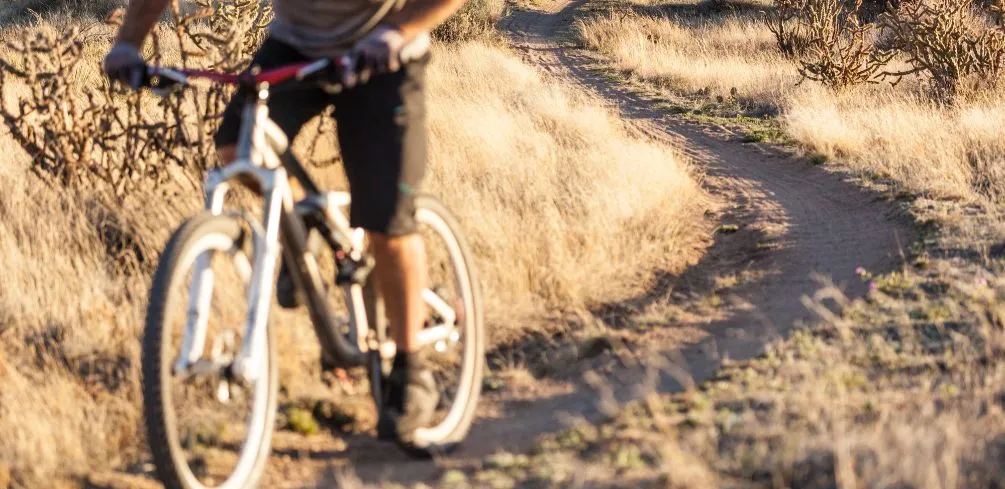The world of mountain biking is vast and varied, encompassing a range of sub-disciplines that cater to different preferences and skill levels.
One such sub-discipline is dirt jumping, which involves performing aerial tricks and stunts on custom-built jumps and features.
While dirt jumping has gained a considerable following in recent years, it has also sparked controversy among mountain biking enthusiasts regarding its impact on trails.
The debate centers around whether dirt jumping is detrimental to the natural environment and existing trail systems.
Some argue that the construction of dirt jumps can cause erosion, destroy vegetation, and disturb wildlife habitats.
Others contend that properly built and maintained jumps can actually benefit trails by promoting responsible riding behavior and drawing more attention to the sport of mountain biking.
This article seeks to examine both sides of the argument in order to determine whether dirt jumpers are good for trails or not.
What Is Dirt Jumping?
Dirt jumping is a popular style of biking within the bike culture that involves performing tricks on specially designed jumps.
The term ‘dirt jumping’ comes from the fact that these jumps are typically made out of dirt, although they can also be made from other materials such as wood or metal. Dirt jumpers are a type of bike that is specifically designed for this style of riding, with features such as strong frames, wide handlebars, and suspension systems that allow riders to absorb impact when landing jumps.
The design of dirt jumps is an important aspect of this sport. Jumps need to be designed in a way that allows riders to gain enough speed to clear them while also providing enough height for tricks.
Jumps can vary in size and shape, with some being long and low while others are tall and steep. Skilled dirt jumpers have an innate understanding of how to approach each jump in order to maximize their speed and achieve the desired trajectory.
Overall, dirt jumping is a thrilling sport that requires skill and precision, making it an exciting part of bike culture for those who enjoy extreme sports.
Pros Of Dirt Jumping
Dirt jumping is a form of mountain biking that involves performing aerial tricks and stunts on specially designed dirt jump tracks. These tracks are typically made up of a series of jumps, berms, and other obstacles that allow riders to gain speed and launch themselves into the air.
Dirt jumpers are designed specifically for this type of riding, with features such as strong frames, short wheelbases, and suspension systems that can handle the high-impact landings that come with performing tricks. While dirt jumpers are primarily designed for use on dirt jump tracks, they can also be used for trail riding in some cases.
However, it’s important to note that the bike setup required for dirt jumping may not be ideal for all types of trails. For example, a dirt jumper may not have enough suspension travel or gearing options to handle steep climbs or technical descents. Additionally, the lightweight frame and components of a dirt jumper may not hold up as well under the constant pounding of trail riding compared to a more heavy-duty trail bike.
Three benefits of using a dirt jumper for trails include:
- Agility: Dirt jumpers are known for their nimble handling and quick acceleration, which can make them ideal for tight and twisty singletrack trails.
- Fun factor: The ability to perform aerial tricks and jumps can add an element of excitement to trail riding that might not be possible on other types of bikes.
- Versatility: While they may not be ideal for all types of trails, dirt jumpers can be a good option for riders who want a bike that can perform well in both dirt jump parks and on less technical trails.
Cons Of Dirt Jumping
According to a study conducted by the International Mountain Biking Association (IMBA), dirt jumping can result in significant erosion of trails. The constant pounding of bikes, particularly those with heavier frames and tires, can wear away soil and vegetation, leading to unsightly scars on the landscape. This not only ruins the visual appeal of the trail but also poses a threat to environmental sustainability.
Trails that are heavily used for dirt jumping require more frequent maintenance than those used for other types of riding due to increased wear and tear. Another downside of dirt jumping is the cost of repairs. The high-impact nature of this sport often leads to damage to equipment and accidents, which can be expensive to fix.
Additionally, repairing damaged trails can be costly and time-consuming, especially if erosion control measures need to be put in place. All these costs add up, making it difficult for parks and recreation departments to justify investing resources in maintaining areas specifically for dirt jumping when they have other pressing needs, such as improving facilities for safer forms of cycling like mountain biking or road cycling.
Therefore, while dirt jumping can be fun and exciting, it is essential that riders take responsibility for mitigating its negative impacts on the environment and infrastructure by adhering strictly to park regulations and practicing proper trail etiquette.
Trail Maintenance And Preservation
Despite the fun and excitement that dirt jumping brings, it also has some disadvantages that must be considered. One of which is its unsuitability for trails. Dirt jumpers are designed for short bursts of high-intensity jumps and stunts, and they are not built for endurance or long-distance riding. Thus, using them on trails can cause discomfort and even injury to the rider.
Additionally, dirt jumping can have a significant impact on the environment, especially when done in unauthorized areas. The construction of jumps and berms can lead to soil erosion and vegetation loss. Moreover, excessive use of these areas can result in trail degradation and increased pollution due to littering.
In response to these environmental impacts, advocacy campaigns have been launched to promote responsible dirt-jumping practices. These campaigns aim to educate riders about proper trail etiquette and encourage them to ride only in designated areas to minimize their environmental footprint.
As outdoor enthusiasts, we have a responsibility to preserve our natural resources while still enjoying the activities we love. While dirt jumping may not be suitable for trails, there are plenty of other ways to enjoy mountain biking while minimizing our environmental impact.
By supporting advocacy campaigns and practicing responsible riding habits, we can ensure that future generations will continue to experience the thrill of mountain biking in pristine environments.
Responsible Riding Practices
As riders, we all share a love for the sport and the freedom that comes with it. However, it is important to remember that with that freedom comes responsibility. Responsible riding practices ensure not only our safety but also the safety of others on the trail.
One crucial aspect of responsible riding is rider etiquette. This includes yielding to other riders and hikers, staying on designated trails, and respecting nature by not littering or damaging plants.
Another important aspect of responsible riding is gear selection. Choosing appropriate gear can make all the difference in preventing injuries and ensuring a comfortable ride. It is essential to wear a properly fitting helmet and protective pads, especially when engaging in more high-risk activities like dirt jumping or downhill riding.
Additionally, choosing the right bike for the type of trail being ridden can greatly enhance both safety and enjoyment on the ride.
| Etiquette | Gear |
|---|---|
| Yield to other riders/hikers | Properly fitting helmet |
| Stay on designated trails | Protective pads |
| Respect nature (no littering/damage) | Appropriate bike for trail type |
Remember, as riders, we are all part of a community that shares a love for this amazing sport. By practicing responsible riding practices like proper rider etiquette and gear selection, we not only keep ourselves safe but also contribute to keeping our trails open and accessible for everyone to enjoy.
Frequently Asked Questions
What Should I Wear When Dirt Jumping?
When it comes to dirt jumping, wearing the appropriate gear is essential for safety and comfort.
The riding techniques involved in dirt jumping require a certain level of protection, such as a full-face helmet, gloves, knee pads, and elbow pads.
It is also important to wear clothing that allows for freedom of movement and breathability.
As for bike setup, choosing the right type of bike for your skill level and the type of terrain you’ll be riding on is crucial.
Dirt jumpers typically have a shorter frame and steeper head angle than other types of bikes, allowing for quick maneuverability in the air.
Additionally, having proper suspension and tire pressure can greatly impact your ability to land jumps smoothly.
Overall, when it comes to what to wear while dirt jumping and bike setup, it’s important to prioritize safety and functionality over fashion or aesthetics.
Can Dirt Jumping Damage My Bike?
Dirt jumping is a high-intensity activity that requires protective gear to ensure the rider’s safety.
The nature of dirt jumping involves performing tricks and jumps on rugged terrain, which can put significant stress on the bike.
While it is possible for dirt jumping to damage a bike, this risk can be minimized with wheel upgrades and proper maintenance.
Riders should invest in sturdy wheels that can withstand the impact of landing jumps, as well as regularly check their bikes for wear and tear.
By taking these measures, riders can enjoy dirt jumping with minimal risk of damaging their equipment.
How Do I Properly Maintain My Dirt Jumping Trail?
Proper maintenance of your dirt jumping trail is essential to ensure a safe and enjoyable experience.
To begin with, it is crucial to use the proper gear when riding, including a full-face helmet, protective gloves, and body armor.
In addition to this, identifying safe spots on the trail is essential for avoiding potential injuries.
It is recommended that you inspect the trail regularly and remove any obstacles or debris that may pose a risk to riders.
Moreover, maintaining proper drainage on the trail can prevent erosion damage caused by water runoff.
By taking these necessary steps, you can maintain your dirt jumping trail safely and enjoyably.
Are There Any Safety Precautions I Should Take When Dirt Jumping?
Safety should always be a top priority when dirt jumping.
To minimize the risk of injury, it is important to take certain safety precautions before hitting the trail.
First, ensure that your bike setup is appropriate for the type of jump you plan on doing.
Make sure your bike is in good condition and has the necessary components such as a sturdy frame, proper brakes, and suspension if needed.
Second, work on improving your jump technique by practicing on smaller jumps and gradually increasing difficulty.
Proper body position and weight distribution can help you land safely and avoid injuries.
It’s also important to wear protective gear such as a helmet, gloves, and knee pads to further reduce the risk of injury.
By taking these safety measures seriously, riders can enjoy dirt jumping with peace of mind.
How Can I Get Involved In Trail Maintenance And Preservation Efforts?
Getting involved in trail maintenance and preservation efforts can be a fulfilling way to contribute to the community while raising environmental awareness.
Community outreach programs exist that can connect individuals with organizations aimed at preserving natural habitats and promoting sustainable land use practices.
Volunteering for trail maintenance activities, such as removing invasive species or building erosion control structures, not only benefits the environment but also fosters a sense of belonging among like-minded individuals who share a passion for outdoor recreational activities.
By participating in these preservation efforts, individuals can make a positive impact on their local ecosystems and promote the responsible use of natural resources.
Conclusion
Dirt jumpers are a popular choice for riders who enjoy hitting jumps and performing tricks. However, many riders wonder if they are suitable for trail riding.
While dirt jumpers may not be the best choice for long-distance rides or technical terrain, they can be a fun and challenging way to tackle trails.
When dirt jumping, it is essential to wear protective gear such as a helmet, gloves, and knee pads to prevent injury. Dirt jumping can also put more stress on your bike than normal trail riding, so regular maintenance is critical to prevent damage.
Proper trail maintenance is necessary for ensuring safety when dirt jumping. Riders should regularly inspect the trail for any hazards or damage and make repairs as needed. It is also important to follow safety guidelines, such as building jumps with appropriate angles and landing zones.
Getting involved in trail maintenance and preservation efforts can help ensure that dirt jumpers have safe places to ride in the future. This includes supporting local advocacy groups, volunteering with trail-building organizations, and following responsible riding practices.
In conclusion, while dirt jumpers may not be the ideal choice for all types of trails, they can offer a fun and exciting way to ride. By taking proper safety precautions, maintaining your bike and trails, and getting involved in advocacy efforts, you can enjoy the thrill of dirt jumping while preserving these unique riding opportunities for future generations.
Through responsible riding practices and commitment to trail preservation efforts, we can continue enjoying this thrilling sport while protecting our environment’s resources.











